

| Previous Flies |
| Fly Tying Terms |
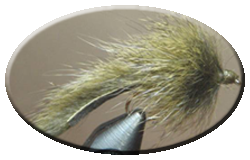
PINE SQUIRREL CHEATER
In the fall of ’07, I was fishing this streamer on the Lower Henry’s Fork of the Snake. Cast down and across with a Class II full sinking line on my 5 wt, the fly hit the water about 40’ from my position. Stripped it twice, just enough to get the slack out of the line, when there was a huge boil just below where the fly had hit. Hot Damn!! When he rolled, I could only see his back to belly, and he was much bigger than any brown I have had on before, or since. I estimated his length to be in the mid to upper 20 inches.
He ran once, paused, and ran again. When I looked down, there were two or three wraps of fly line over the backing.
Below me was a deep fast run that I could not wade to follow him. I knew that if this fish got downstream into that water, I would lose him down there, lose my rig, or kill him if I happened to actually crank him back upstream against the current. In an instant, I decided to hold him. He shook his head a couple times, the 2X tippet broke, and he was gone; one of the grand ten second memories of my fly fishing experience.
This fly actually came about because of my lack of fly tying skills. I had watched one of our outstanding Idaho Falls area fly fisherman demonstrate a bunny sculpin pattern at a local TU affiliated club meeting. When he got the rabbit zonker to the point he wanted to start the collar, he put the zonker in a dubbing loop, cut the hair off the skin, and proceeded to dub the collar with the hair. Couldn’t do the dubbing loop thing the way he did. So I started looking around and ended up tying a similar but simpler fly, this one, with pine squirrel zonkers.
The fly has been my go to streamer for every kind of trout water I fish. Browns, bows, cutts, brookies, and mountain whitefish, in many rivers and streams in SE Idaho, and, more recently, some Bitterroot River MT pike minnow, have decided it is food, not fake.
Materials:
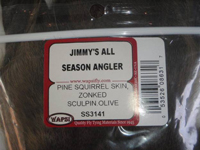
Tying Sequence:
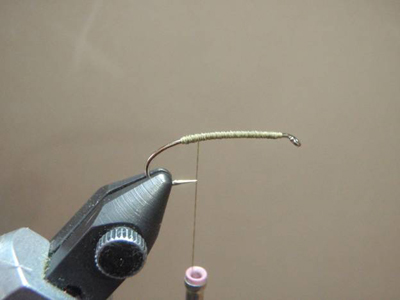 Lay a good thread base. Start behind the eye, lay close wraps back to the
bend, make a return trip to the eye and then wrap back to over the barb. This
colors the hook and gives the thread a good bite when you tie on the zonker
strip.
Lay a good thread base. Start behind the eye, lay close wraps back to the
bend, make a return trip to the eye and then wrap back to over the barb. This
colors the hook and gives the thread a good bite when you tie on the zonker
strip.
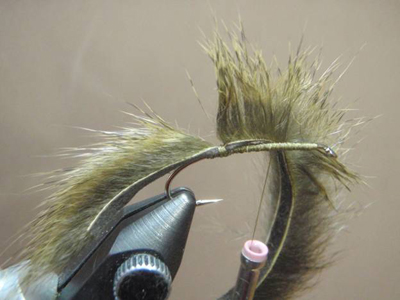 With the hair lying toward the back of the fly, hang about ¾ inch of
hide off the bend and tie the zonker strip securely to the hook. It helps
to dampen the hair on both sides of the tie in point and “part” it
before tying. Also, take several wraps over the zonker strip, then a couple
in front of it, and then several more over it and a couple more in front to
ensure that it will stay in place on top of the hook shank.
With the hair lying toward the back of the fly, hang about ¾ inch of
hide off the bend and tie the zonker strip securely to the hook. It helps
to dampen the hair on both sides of the tie in point and “part” it
before tying. Also, take several wraps over the zonker strip, then a couple
in front of it, and then several more over it and a couple more in front to
ensure that it will stay in place on top of the hook shank.
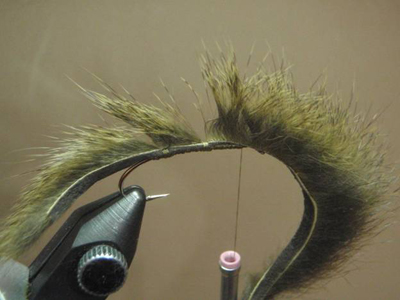 Wrap the tying thread forward to midshank. Again, dampen and part the hair
before tying the zonker strip securely to the hook at midshank. Use the same
technique as above, but a few extra wraps both over and in front of the strip
will help keep it in place as you start the next step. Wrap the thread forward
to just behind the eye.
Wrap the tying thread forward to midshank. Again, dampen and part the hair
before tying the zonker strip securely to the hook at midshank. Use the same
technique as above, but a few extra wraps both over and in front of the strip
will help keep it in place as you start the next step. Wrap the thread forward
to just behind the eye.
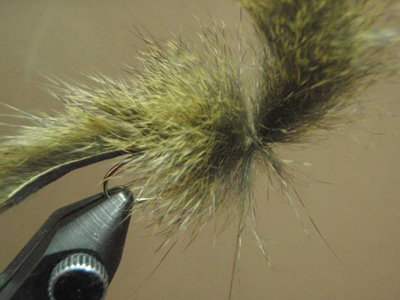 Wrap the zonker strip forward as a collar. As you wrap it forward, stroke
the hair backwards to keep it free of the wraps. It usually takes around seven
or eight wraps to reach the eye. You may take more or less, depending on your
own tying style.
Wrap the zonker strip forward as a collar. As you wrap it forward, stroke
the hair backwards to keep it free of the wraps. It usually takes around seven
or eight wraps to reach the eye. You may take more or less, depending on your
own tying style.
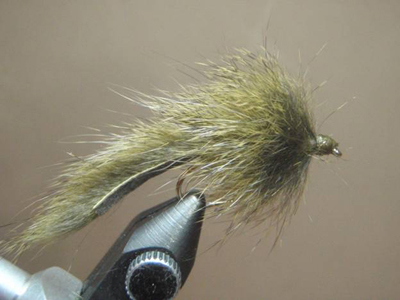 Tie the zonker strip securely to the hook just behind the eye using the same
tie in technique described in steps 2 and 3. Cut the excess zonker strip and
wrap numerous thread layers back about two / three eye lengths from the eye
to form a neat head. I usually take a couple five- or six-turn whip finishes
and apply a liberal coating of water based head cement to finish the fly.
Tie the zonker strip securely to the hook just behind the eye using the same
tie in technique described in steps 2 and 3. Cut the excess zonker strip and
wrap numerous thread layers back about two / three eye lengths from the eye
to form a neat head. I usually take a couple five- or six-turn whip finishes
and apply a liberal coating of water based head cement to finish the fly.
This is a rather small, unweighted streamer. I fish it off a class II full sinking line with a 3-4’ 2X leader / tippet, regardless of the type of water, and it works in just about any kind of trout water. Depending on current speed, depth, and potential lies, it can be fished up and across with a downstream mend to race it downstream, across or down and across and swung or stripped. I get the best results using a short, steady strip. Letting it hang momentarily at the end of the swing before again stripping it in will occasionally pick up a fish. In slow or still water, the same short, steady strip works best. In close quarters, where casting is not possible, it can be drifted downstream below the potential lie and then stripped back up through the lie.
Simple, easy to tie, durable and effective; The Pine Squirrel Cheater.
Fly of the week Archives
For more great flies, check out: Beginning Fly Tying, Intermediate Fly Tying and Advanced Fly Tying.
[ HOME ]
[ Search ] [ Contact FAOL ] [ Media Kit ]